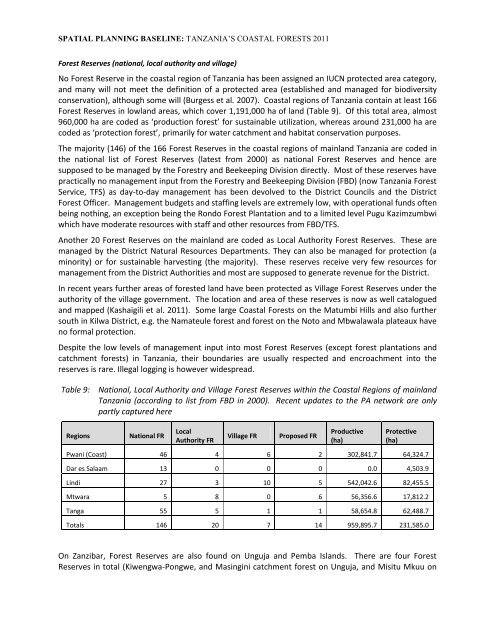Neil D. Burgess, Paul Harrison, Peter Sumbi, James Laizer, Adam ...
Neil D. Burgess, Paul Harrison, Peter Sumbi, James Laizer, Adam ...
Neil D. Burgess, Paul Harrison, Peter Sumbi, James Laizer, Adam ...
Create successful ePaper yourself
Turn your PDF publications into a flip-book with our unique Google optimized e-Paper software.
SPATIAL PLANNING BASELINE: TANZANIA’S COASTAL FORESTS 2011<br />
Forest Reserves (national, local authority and village)<br />
No Forest Reserve in the coastal region of Tanzania has been assigned an IUCN protected area category,<br />
and many will not meet the definition of a protected area (established and managed for biodiversity<br />
conservation), although some will (<strong>Burgess</strong> et al. 2007). Coastal regions of Tanzania contain at least 166<br />
Forest Reserves in lowland areas, which cover 1,191,000 ha of land (Table 9). Of this total area, almost<br />
960,000 ha are coded as ‘production forest’ for sustainable utilization, whereas around 231,000 ha are<br />
coded as ‘protection forest’, primarily for water catchment and habitat conservation purposes.<br />
The majority (146) of the 166 Forest Reserves in the coastal regions of mainland Tanzania are coded in<br />
the national list of Forest Reserves (latest from 2000) as national Forest Reserves and hence are<br />
supposed to be managed by the Forestry and Beekeeping Division directly. Most of these reserves have<br />
practically no management input from the Forestry and Beekeeping Division (FBD) (now Tanzania Forest<br />
Service, TFS) as day-to-day management has been devolved to the District Councils and the District<br />
Forest Officer. Management budgets and staffing levels are extremely low, with operational funds often<br />
being nothing, an exception being the Rondo Forest Plantation and to a limited level Pugu Kazimzumbwi<br />
which have moderate resources with staff and other resources from FBD/TFS.<br />
Another 20 Forest Reserves on the mainland are coded as Local Authority Forest Reserves. These are<br />
managed by the District Natural Resources Departments. They can also be managed for protection (a<br />
minority) or for sustainable harvesting (the majority). These reserves receive very few resources for<br />
management from the District Authorities and most are supposed to generate revenue for the District.<br />
In recent years further areas of forested land have been protected as Village Forest Reserves under the<br />
authority of the village government. The location and area of these reserves is now as well catalogued<br />
and mapped (Kashaigili et al. 2011). Some large Coastal Forests on the Matumbi Hills and also further<br />
south in Kilwa District, e.g. the Namateule forest and forest on the Noto and Mbwalawala plateaux have<br />
no formal protection.<br />
Despite the low levels of management input into most Forest Reserves (except forest plantations and<br />
catchment forests) in Tanzania, their boundaries are usually respected and encroachment into the<br />
reserves is rare. Illegal logging is however widespread.<br />
Table 9: National, Local Authority and Village Forest Reserves within the Coastal Regions of mainland<br />
Tanzania (according to list from FBD in 2000). Recent updates to the PA network are only<br />
partly captured here<br />
Regions<br />
National FR<br />
Local<br />
Authority FR<br />
Village FR<br />
Proposed FR<br />
Productive<br />
(ha)<br />
Protective<br />
(ha)<br />
Pwani (Coast) 46 4 6 2 302,841.7 64,324.7<br />
Dar es Salaam 13 0 0 0 0.0 4,503.9<br />
Lindi 27 3 10 5 542,042.6 82,455.5<br />
Mtwara 5 8 0 6 56,356.6 17,812.2<br />
Tanga 55 5 1 1 58,654.8 62,488.7<br />
Totals 146 20 7 14 959,895.7 231,585.0<br />
On Zanzibar, Forest Reserves are also found on Unguja and Pemba Islands. There are four Forest<br />
Reserves in total (Kiwengwa-Pongwe, and Masingini catchment forest on Unguja, and Misitu Mkuu on

















